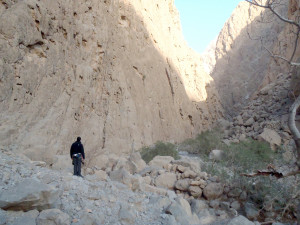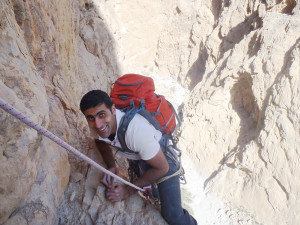Words + Photos: Pete Aldwinckle
Many climbing related articles have little of interest for non-climbers as the focus are often technical climbing details and use of jargon such as crimp, crush, send, sloper and similar. However, the majority of people will relate to the situation when you just do not want to pick up the phone when it’s your parents calling. This is usually due to their immaculately bad timing such as children’s bath time, when you are in a noisy location with rowdy company, who will be very enthusiastic to talk to them or just at the end of a bad day that you do not want to burden them with.
 My parents were calling on my mobile, this was definitely a “do not answer moment.” The timing was very bad and potential subject matter of discussion would be incomprehensible to them. I was hanging on a thin rope 200m directly above the wadi floor with 100m above me to the top of the rock wall. Hanging between my legs was an industrial hammer drill and my rucksack was laden with spare batteries, water and other accoutrements of sports climbing route development. A cooling breeze was slowly spinning me round giving views of sweeping vertical rock walls, the moon rising over the mountains on the other side of the wadi and the ground below me disappearing into an increasingly inky darkness.
My parents were calling on my mobile, this was definitely a “do not answer moment.” The timing was very bad and potential subject matter of discussion would be incomprehensible to them. I was hanging on a thin rope 200m directly above the wadi floor with 100m above me to the top of the rock wall. Hanging between my legs was an industrial hammer drill and my rucksack was laden with spare batteries, water and other accoutrements of sports climbing route development. A cooling breeze was slowly spinning me round giving views of sweeping vertical rock walls, the moon rising over the mountains on the other side of the wadi and the ground below me disappearing into an increasingly inky darkness.
The phone continued to ring, but I realised I was too exhausted to even contemplate answering it. With 100m still to ascend to the safety of the summit, I needed to conserve my energy. Every metre gained ascending the rope was a struggle between the desire to be safe and my body telling me that enough was enough. Think being strapped into a gym exercise machine, pushing yourself to your limit, then repeating it for the rest of the day, and every time you stop you’re given electric shocks and beaten until you restarted.
This self-imposed masochism was almost the culmination of an 18-month project that had developed into a near obsession. The previous summer, Mike Nott had taken Toby Foord-Kelcey and me to a potential climbing location near Dibba. Mike had named it “Nant Biddy.” A short walk from the end of the road took us into a narrow wadi with towering rock walls on either side. Unlike many of the cliffs in the region, one of these walls was not a series of steep sections divided by horizontal steeps; it was vertical and in some areas there were enormous capping overhangs above steep slabs. This was a truly unique mountain feature for the region.
Early autumn 2011, Toby and I made our first attempt on this wall from the ground up using traditional climbing techniques. We were repulsed without making significant progress. Loose rock, heat and dehydration, lack of protection and the enormity of the undertaking got the better of us. A different approach was required, so we carried drums of rope, drills and bolts the long way around to the top and abseiled down to work out the complex topography of the wall. After several weekends of exploration and numerous aborted forays down potential lines, we indentified a continuous line that appeared to be climbable from the wadi floor to the top. The following months were spent cleaning the loose rock from the route, bolting and generally scaring ourselves. By the end of summer, there was a nearly established route, only two relatively short sections remained. Toby completed one of them prior to his departure to Canada and despite the best efforts of the revised Dibba border protocols, I had now closed the final gap. Eleven pitches of climbing with 300m of vertical ascent were waiting for an attempt from the ground up.
I did reach the summit of the mountain after my parents call, and by eight o’clock the following morning, Hamad and I are on pitch one.
We are sharing a rucksack with a couple of litres of water, some snacks and our walking shoes for the descent from the top via potentially ankle-breaking boulder fields. We had set ourselves a target of climbing a pitch every hour in order to get over the major difficulties during daylight with the final relatively easier climbing and descent to be completed by head torch. Hamad was now climbing pitch one, with me who sat safely at the first belay. Suddenly the rope snapped as Hamad’s weight came on it and a large piece of rock crashed into the wadi below, not the ideal start.
Pitch two was dispatched without drama. I was now leading pitch three, the first relatively hard section of the route that required climbing an overhanging corner that would give access to a relatively easier groove and slab system. The previous day’s exertions caught up with me high in the corner. My fingers slowly opened and despite a desperate lunge for better holds, I was falling into the void below the corner. After a short rest, I returned to the struggle in the groove and made some progress until I was again falling and swinging in free space. These processes we repeated several more times until, with heaving lunges and destroyed arms, I pulled myself onto the belay ledge. Once Hamad joined me on the ledge, retreat was now impossible, we were committed to climbing to the top as our ropes would not reach the ground and the rock topography made it impossible to abseil to the previous belay stances.
Two further pitches of climbing established us on “The Balcony” about an hour ahead of our schedule. This was the first good ledge to take a rest. It was also where Hamad was hit by the mind-numbing exposure, expressed in a few unrepeatable expletives. He recovered from this wobble and confidently led the next pitch up a very steep wall with a couple of hanging tombstones of rock attached to the main wall by a thin layer of crumbling mud.
We continued upwards until the penultimate pitch. I knew it would be extremely difficult climbing, but had completely misjudged just how difficult. Fortunately, the rope I had used to ascend the wall the previous night was still in place and with some Boy Scout knots and improvisation, we overcame the difficulties and headed to the summit. Changing into walking shoes for the descent was a relief as our feet were skinned, numb and bleeding from our climbing shoes. Eleven hours after leaving the car, we were back where we started.
Our route, still unnamed: F6a, 6a, 6b+, 6a, 6b+, 6b, 5, 6a, 4, A2 (hooks)/8a+?, 5 and scramble to the top; approximately 350m.
A note of caution to those that enter into “Nant Biddy” (turn left at Dabba Dam, follow tarmac road to dirt road to the far side of small village and park just beyond the stone bungalow on the rise after the dip in the track). The residents of the village close to “Nant Biddy” should not have to put up with inconsiderate driving or parking, car door slamming, indiscreetly dressed climbers, litter and rubbish etc. If you are going to “Nant Biddy,” be on your very best behaviour at all times. Particularly to the elderly gentlemen that lives in the bungalow where you will park. While his behaviour may appear a little eccentric, it is his house and you are on his land, so please be polite, humble and discrete.
In addition to the route described above, there are a number of single pitch sports and traditional climbs in “Nant Biddy.” This is an extremely serious climbing venue of Alpine proportions. Good rope work, self-sufficiency and an ability to sensibly improvise when required are all required once you move more than one pitch off the wadi floor. There is potential for falling rock, cut ropes and debilitating exposure. While death or serious injury is not guaranteed, be prepared to be challenged and very scared.
Many thanks to Toby Foord-Kelcey for his major contribution to this project and companionship on the wall. Guida, Theo and Marie for their supporting roles. And Hamad for joining me on a great day out on the wall, you can go back to your boulders now.



